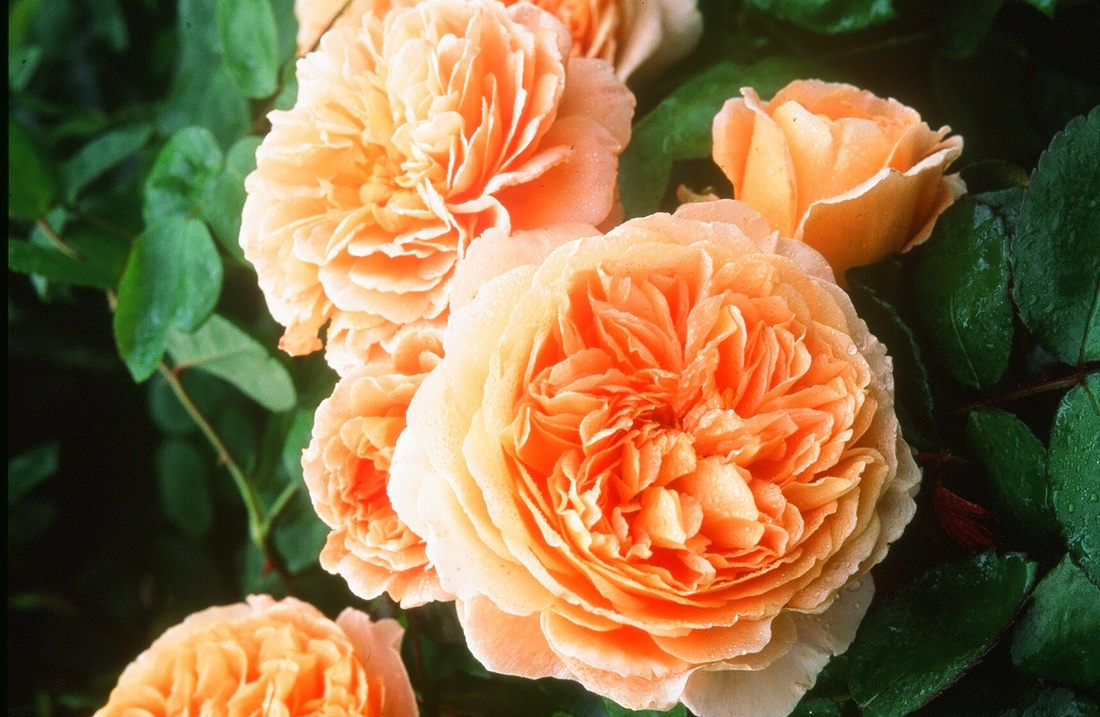| Old-fashioned roses are often more hardy and easier to take care of than newer hybrid floribundas and teas, but some modern varieties are deliciously fragrant. And the billions of new colors and forms are enticing. Even David Austin Roses, from England, do well here – sometimes even more so than back in their homeland, since our weather is much more consistently mild. A couple of mine, instead of their catalog-description-promised 3-4 foot height, burgeon to 7-8 feet. While others were twiggy and short, they still produce gloriously blousy blooms for gathering into a short vase. Fragrance The seven basic scents most often found in hybrid tea roses are apple, clover, lemon, nasturtium, orris, rose, and violet. Others are anise, bay, fern, geranium, honey, hyacinth, lily-of-the-valley, linseed oil, marigold, moss, orange, parsley, peppers, quince, raspberry, and wine. In general, the most highly scented roses are darker in color, have more petals to the flower, or have thick, velvety petals. Reds and pinks tend to smell "like a rose;" whites and yellows like lemon, orris, nasturtium, and violet; oranges like clover, fruit, orris, nasturtium, and violet. Fragrance is strongest early on warm, sunny days when the soil is moist. Only two varieties seem immune to the vagaries of the weather -- Chrysler Imperial and Sutter's Gold are fragrant even on cool, cloudy days. For more intense fragrance, consider these varieties: Ardoisee De Lyon, Chrysler Imperial, Crimson Glory, Dolly Parton, Double Delight, Elle Rose, Fourth of July, Fragrant Cloud, Fragrant Plum, Garden Party, Gertrude Jekyll, Granada, Honey Perfume, Intrigue, Ivory Fashion, Lemon Sherbet, Lilac Charm, Memorial Day, Mister Lincoln, Mme Legras de St Germain, Papa Meilland, Rosa Mulliganii, Scentimental, Sheer Bliss, Sunsprite, Sutter's Gold, Sweet Surrender, Tiffany, Tuscany. Best cutting roses Apricot: Sunset Celebration Lavender: Barbra Streisand, Neptune, Stainless Steel Red: Mr. Lincoln, Olympiad, Viva Pink: America, Bewitched, Cherish, Color Magic, Duet, Sonia, Touch of Class, Voodoo, Memorial Day Purple: Deep Purple, Intrigue, Paradise White: French Lace, Honor, Iceberg, Pascali Orange: About Face, Gingersnap, Marina, Prominent Yellow: Gold Medal, New Day, Summer Sunshine, St. Patrick Pruning Now’s the time to prune established roses even if they have not lost all their leaves. However, climbers and old-fashioned roses with a single bloom cycle in the spring should be pruned following that bloom. Remove crowded or crossed branches, and open the center of the plant for good light exposure and airflow. This encourages new growth to reach out into open space, and better air circulation lessens the likelihood for disease spores to settle in. Height and how many stems to remove can be completely up to you. Early on when I’d moved back home, I was so preoccupied with reviving and pruning the fruit trees that I made only a single chopping of all rose branches at elbow height – literally just hacking everything at that level - meaning to come back later to fine-tune my pruning. I never did, and those roses produced more healthy stems and blooms than they every had with more extensive pruning. So, always eager to do less work for more productive results, I’ve pruned this way ever since. Prune branches above a bud that faces outward or toward a side that needs filling in. No need to worry about cutting at a 45-degree angle, since we don’t get rose borers or so much rain as is the case on the east coast to require that angle. Remove any leaves that have dead or diseased portions, and destroy (don't compost) them. This accomplishes two things: 1) completely removes any disease spores that may be lingering – even if not yet seen – on leaves, and 2) forces the plants into dormancy (however short the weather may allow), which enables the plant to rest and gain energy before expending energy in growth and blooms for the whole coming seasons. This dormancy issue means that pruning earlier in late fall or early winter is a better idea than waiting until now – so plan for next year! When new shoots appear in several weeks, you can easily flick away with a finger those that insist on growing back into the middle of the plant or into another stem. However, you may want to keep the new shoot in place of an older one, depending on which one looks like it’ll become more substantial and balance the growing of the entire plant. As more shoots develop, you can continue to rethink which you choose to remove and which to remain in the interest of the overall look of the plant. |
|
0 Comments
Leave a Reply. |
Categories |









 RSS Feed
RSS Feed